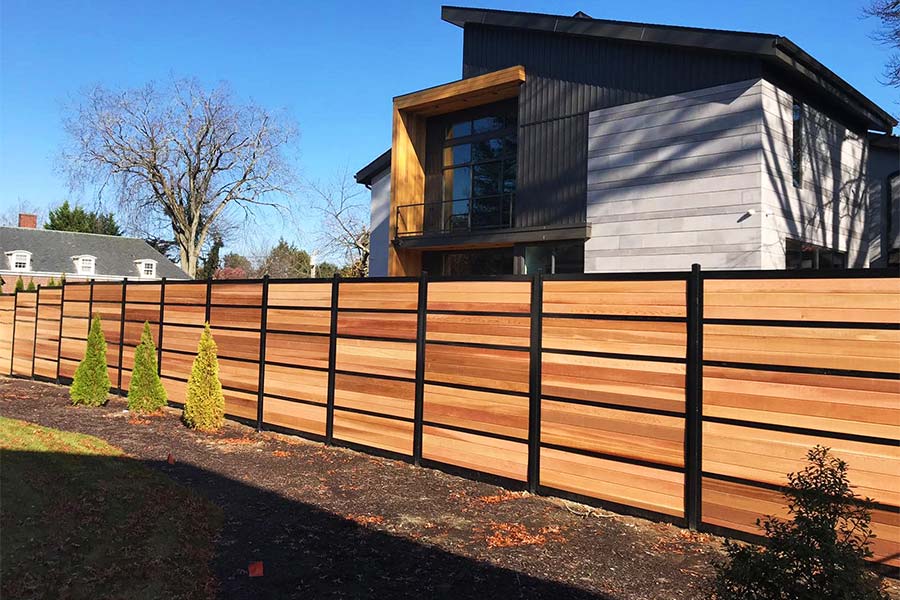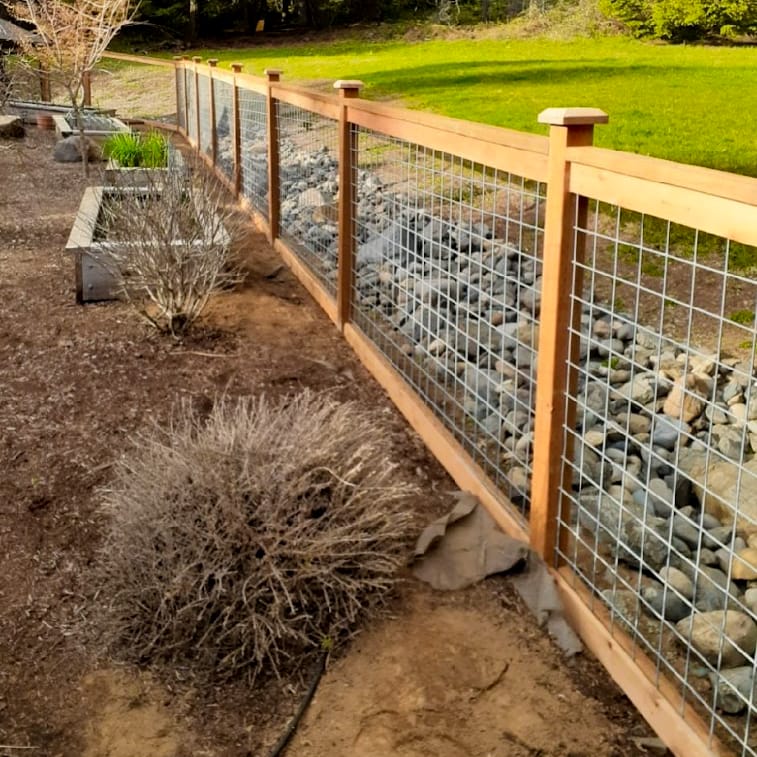All Categories
Featured
When it comes to securing and enhancing your property, choosing the right fence material is a critical decision. With a variety of alternatives offered, picking the best material for your demands calls for mindful consideration of factors such as protection, privacy, visual appeals, budget, and lasting upkeep. Whether you are installing a fence for your home or business, each product has its very own set of benefits and disadvantages. In this comprehensive overview, we'll explore one of the most preferred secure fencing materials to assist you make an informed option.
Benefits:
Natural aesthetic. High customization (discolorations, paints) When constructed tall), good personal privacy (. Reasonably budget friendly. Disadvantages:
Requires routine upkeep (painting or discoloration) Prone to weather damages, bugs, and rot. Shorter life expectancy contrasted to other products. Best For: Home owners seeking a warm, traditional look with high modification capacity.
Advantages:
![]()
Low upkeep (no paint or discoloration) Resistant to weather, rot, and insects. Durable (can last approximately three decades or even more) Range of shades and designs. Negative Aspects:
First cost can be more than wood. Can break or damage in severe climate problems (such as hefty impact) Restricted customization (compared to wood) Best For: Home owners and businesses trying to find a low-maintenance, long lasting, and lasting fencing remedy.
Benefits:
Incredibly resilient and protected. Reduced upkeep (especially aluminum) Aesthetic allure (particularly wrought iron) Great for high-security areas. Disadvantages:
Can be costly (especially functioned iron and steel) Not as private (unless incorporated with other products) Can corrosion (iron and steel need protective finishes) Best For: Home owners and services that require additional security, or those looking for a premium, traditional design.
Advantages:
Cost effective and very easy to set up. Low maintenance. Offers safe and secure limits. Perfect for large residential properties or pet rooms. Downsides:
Offers restricted privacy and looks (unless combined with slats or covers) Can be viewed as unappealing in specific setups. Prone to rust otherwise treated. Best For: Huge buildings, protection fencings, or locations where budget is a priority over aesthetic appeals.
Benefits:
![]()
Low upkeep (no staining or securing called for) Immune to fading, rot, and bugs. Durable and solid. Aesthetic charm comparable to timber. Drawbacks:
Greater preliminary cost compared to timber. Minimal customization choices (compared to all-natural wood) Can become weak in extreme chilly temperatures. Best For: Home owners that want the look of wood yet with a much more long lasting and low-maintenance alternative.
Advantages:
Incredibly sturdy and safe. Reduced maintenance. Deals premium personal privacy and soundproofing. Includes value to your property. Downsides:
High first price. Labor-intensive installment. Minimal design selection (even more typical designs) Best For: High-end houses or companies calling for a durable, secure, and stylish fence.
Advantages:
Ecologically pleasant and renewable. One-of-a-kind and visually pleasing. Lightweight and simple to mount. Can be used as an ornamental component. Disadvantages:
![]()
Prone to weathering and damages gradually (unless dealt with) Calls for routine upkeep to prevent decomposing or splitting. Less safe and secure than timber, stone, or metal. Best For: Eco-conscious property owners looking for a trendy and natural fence solution.
Just How to Pick the Right Product. When picking the most effective secure fencing product for your property, take into consideration the list below variables:
Spending plan: Some materials like timber and chain link are extra affordable, while others, like stone and wrought iron, are a lot more costly. Upkeep: If you're looking for a low-maintenance option, vinyl, metal, or composite products are excellent selections. Objective: Consider whether your key need is security, personal privacy, or appearances. For chain, safety or metal web link fences may be best, while timber or plastic may suit those looking for privacy. Visual Preferences: The product you select should complement the layout and design of your building. Timber supplies a rustic beauty, while metal and rock provide an even more formal or contemporary appearance. Sturdiness: Some materials, like plastic and steel, offer resilient toughness, while others, like timber, might need more maintenance with time. Final thought. Picking the ideal fence material is a vital choice that influences your building's safety, privacy, and aesthetic appeal. With a selection of options readily available, from all-natural wood to low-maintenance plastic and sturdy metal, it is essential to evaluate each product's disadvantages and advantages based upon your particular requirements and choices. Whether you are seeking a decorative addition or a useful limit, this guide will help you make the finest choice for your property.
- Wood Secure fencing. Timber fencings are a traditional and functional selection that supplies all-natural charm and personal privacy. They come in numerous designs, including picket, privacy, and post-and-rail, making them adaptable to different residential property kinds and choices. Timber provides a standard, rustic charm, suitable for residential setups, and is simple to personalize with paint or spots.
Benefits:
Natural aesthetic. High customization (discolorations, paints) When constructed tall), good personal privacy (. Reasonably budget friendly. Disadvantages:
Requires routine upkeep (painting or discoloration) Prone to weather damages, bugs, and rot. Shorter life expectancy contrasted to other products. Best For: Home owners seeking a warm, traditional look with high modification capacity.
- Plastic (PVC) Fence. Plastic fences are ending up being progressively popular due to their toughness and reduced upkeep demands. Made from synthetic products, vinyl fencings are resistant to weather, parasites, and decay. They provide the appearance of timber yet without the upkeep, making them a wonderful option for both household and industrial properties.
Advantages:

Low upkeep (no paint or discoloration) Resistant to weather, rot, and insects. Durable (can last approximately three decades or even more) Range of shades and designs. Negative Aspects:
First cost can be more than wood. Can break or damage in severe climate problems (such as hefty impact) Restricted customization (compared to wood) Best For: Home owners and businesses trying to find a low-maintenance, long lasting, and lasting fencing remedy.
- Metal Fence (Light Weight Aluminum, Steel, Wrought Iron) Metal fencings are prominent for their stamina, security, and ageless beauty. Light weight aluminum and functioned iron fencings supply an innovative, high end look, commonly made use of for decorative purposes, while steel fences are selected for their durable security features.
Benefits:
Incredibly resilient and protected. Reduced upkeep (especially aluminum) Aesthetic allure (particularly wrought iron) Great for high-security areas. Disadvantages:
Can be costly (especially functioned iron and steel) Not as private (unless incorporated with other products) Can corrosion (iron and steel need protective finishes) Best For: Home owners and services that require additional security, or those looking for a premium, traditional design.
- Chain Web Link Secure Fencing. Wire mesh fence are a cost-effective and useful choice, specifically for huge properties or locations requiring easy, practical boundaries. They are commonly used in both domestic and industrial setups and can be incorporated with privacy slats for added seclusion.
Advantages:
Cost effective and very easy to set up. Low maintenance. Offers safe and secure limits. Perfect for large residential properties or pet rooms. Downsides:
Offers restricted privacy and looks (unless combined with slats or covers) Can be viewed as unappealing in specific setups. Prone to rust otherwise treated. Best For: Huge buildings, protection fencings, or locations where budget is a priority over aesthetic appeals.
- Compound Fence. Compound fencings incorporate timber fibers and plastic to develop a material that is both solid and low upkeep. They offer the appearance of timber with the toughness of plastic and are available in numerous shades and textures.
Benefits:

Low upkeep (no staining or securing called for) Immune to fading, rot, and bugs. Durable and solid. Aesthetic charm comparable to timber. Drawbacks:
Greater preliminary cost compared to timber. Minimal customization choices (compared to all-natural wood) Can become weak in extreme chilly temperatures. Best For: Home owners that want the look of wood yet with a much more long lasting and low-maintenance alternative.
- Rock and Brick Fence. Stone and brick fences are superb for those seeking optimum resilience and a high-end aesthetic. These fences use unrivaled protection, personal privacy, and long life, making them excellent for respected buildings or industrial buildings that call for a durable barrier.
Advantages:
Incredibly sturdy and safe. Reduced maintenance. Deals premium personal privacy and soundproofing. Includes value to your property. Downsides:
High first price. Labor-intensive installment. Minimal design selection (even more typical designs) Best For: High-end houses or companies calling for a durable, secure, and stylish fence.
- Bamboo Fencing. Bamboo is a green choice that gives a natural, rustic look while offering moderate security and privacy. It's ending up being a preferred for eco-conscious homeowners who like a more sustainable product.
Advantages:
Ecologically pleasant and renewable. One-of-a-kind and visually pleasing. Lightweight and simple to mount. Can be used as an ornamental component. Disadvantages:

Prone to weathering and damages gradually (unless dealt with) Calls for routine upkeep to prevent decomposing or splitting. Less safe and secure than timber, stone, or metal. Best For: Eco-conscious property owners looking for a trendy and natural fence solution.
Just How to Pick the Right Product. When picking the most effective secure fencing product for your property, take into consideration the list below variables:
Spending plan: Some materials like timber and chain link are extra affordable, while others, like stone and wrought iron, are a lot more costly. Upkeep: If you're looking for a low-maintenance option, vinyl, metal, or composite products are excellent selections. Objective: Consider whether your key need is security, personal privacy, or appearances. For chain, safety or metal web link fences may be best, while timber or plastic may suit those looking for privacy. Visual Preferences: The product you select should complement the layout and design of your building. Timber supplies a rustic beauty, while metal and rock provide an even more formal or contemporary appearance. Sturdiness: Some materials, like plastic and steel, offer resilient toughness, while others, like timber, might need more maintenance with time. Final thought. Picking the ideal fence material is a vital choice that influences your building's safety, privacy, and aesthetic appeal. With a selection of options readily available, from all-natural wood to low-maintenance plastic and sturdy metal, it is essential to evaluate each product's disadvantages and advantages based upon your particular requirements and choices. Whether you are seeking a decorative addition or a useful limit, this guide will help you make the finest choice for your property.
Latest Posts
Uncover the Best Auto Repair Deals in Montclare, Chicago
Published en
1 min read
How to Know When Your Car Needs Skilled Auto Repair at Montclare Auto Repair
Published en
1 min read
The Benefits of Regular Car Maintenance at Montclare Auto Repair Reduces Costs
Published en
1 min read
More
Latest Posts
Uncover the Best Auto Repair Deals in Montclare, Chicago
Published May 27, 25
1 min read
How to Know When Your Car Needs Skilled Auto Repair at Montclare Auto Repair
Published May 27, 25
1 min read
The Benefits of Regular Car Maintenance at Montclare Auto Repair Reduces Costs
Published May 22, 25
1 min read